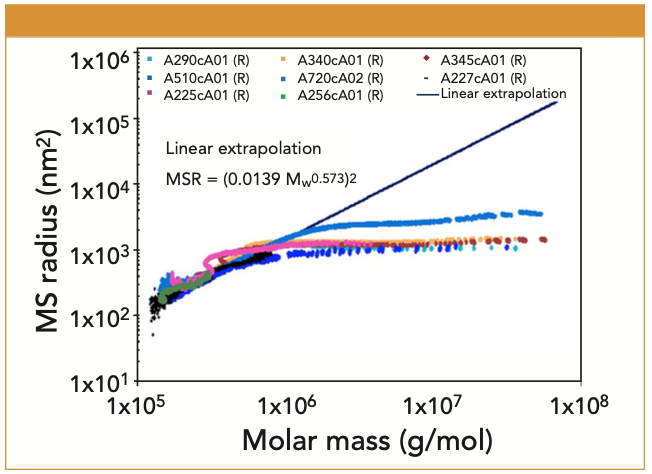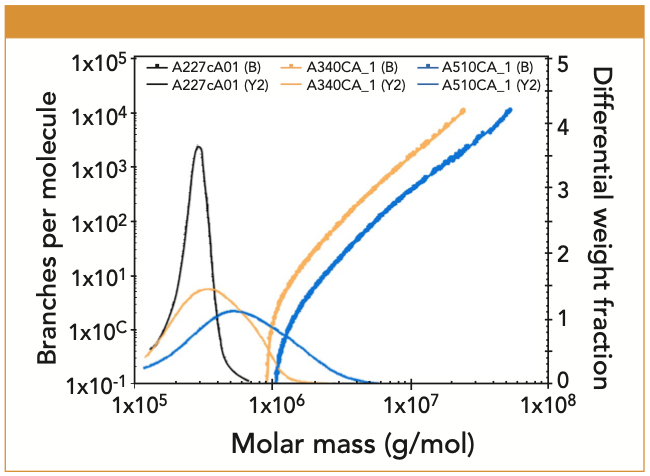Wyatt - SEC-MALS Analysis of Linear and Branched Synthetic Amyloses
Amylose is an occasionally-branched biopolymer and, together with amylopectin, the hyper-branched component, a constituent of starch. Determination of branching in amylopectin, an important property affecting viscosity, stiffness, and thermo-mechanical performance, requires a fully-linear amylose analog. This application note describes how synthetic amyloses from enzymatic (phosphorolytic) reaction were checked for their linearity using SEC-MALS.
Materials and Methods
Separations were performed on Shodex OHpak HQ-806, -805, -804, and -803 size-exclusion chromatography (SEC) columns. A DAWN® multi-angle light scattering (MALS) detector and Optilab® differential refractometer were placed downstream of the columns to analyze molar mass and size of each eluting fraction. Data were acquired and analyzed by ASTRA® chromatography software to calculate differential weight distributions, conformation plots of mean-square radius vs. molar mass, and branching per molecule.
The molar mass M and root-mean-square radius Rg were calculated at each slice using dn/dc = 0.146 mL/g. At least three data sets per sample were averaged together.
Results and Discussion
Branching calculations (branching ratio gM, branches per molecule B and long-term branching λ) were performed using the Zimm-Stockmayer equations (trifunctional random branching). The molar mass distributions of low-molar-mass (LMM) synthetic amyloses are narrow in the range of 1–4 × 105 g/mol, and the branching calculations show that these polymers are strictly linear. The differential weight distribution plots of high-molar-mass (HMM) amyloses show a broader distribution extending into the 106 g/mol range. A distinct halt to the rise of Rg with increasing M is noticeable beginning around 1 million g/ mol (Figure 1). Rigorous analysis shows that branching starts (B = e0) at approximately 8 × 105 g/mol (Figure 2).
Figure 1: Eight synthetic amyloses and linear extrapolation of the equation obtained from LMM amyloses to 108 g/mol.

Figure 2: Differential weight distribution (Y2) and branches per molecule (B) in three synthetic amyloses.

Conclusions
A fully linear amylose was synthesized for use in branching analysis of naturally hyperbranched amylopectin. The synthetic amylose samples analyzed here were linear in the low-molar-mass range up to ~800,000 g/mol, but exhibited branching at higher molar masses.
Even though the linear samples ended at 800,000 g/mol, the conformation plot of linear amylose can be safely extrapolated up to 108 g/mol, enabling analysis of quite large amylopectins. Hence the SEC-MALS method using a DAWN detector and Optilab has proved to be useful to check branching in HMM biopolymers on the basis of linear LMM biopolymers and, by extension, in hyper-branched biopolymers as well.

Wyatt Technology Corporation
6330 Hollister Ave., Santa Barbara, CA 93117
tel: (805) 681-9009
Website: www.wyatt.com










